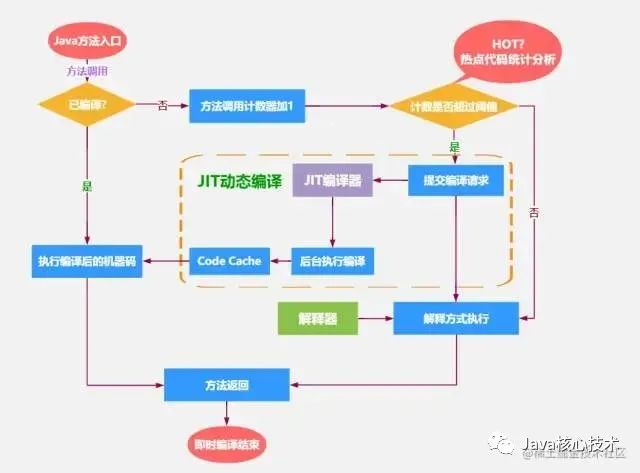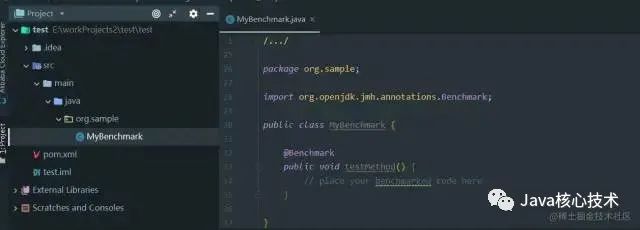关注Java后端编程,推送更多 Java 干货!
来源:https://juejin.cn/post/6844903936869007368
前言
"If you cannot measure it, you cannot improve it".
在日常开发中,我们对一些代码的调用或者工具的使用会存在多种选择方式,在不确定他们性能的时候,我们首先想要做的就是去测量它。大多数时候,我们会简单的采用多次计数的方式来测量,来看这个方法的总耗时。

也就是说,JVM会不断的进行编译优化,这就使得很难确定重复多少次才能得到一个稳定的测试结果?所以,很多有经验的同学会在测试代码前写一段预热的逻辑。
本篇主要是介绍JMH的DEMO演示,和常用的注解参数。希望能对你起到帮助。
DEMO 演示
这里先演示一个DEMO,让不了解JMH的同学能够快速掌握这个工具的大概用法。
1. 测试项目构建
JMH是内置Java9及之后的版本。这里是以Java8进行说明。另外,最新最全的 Java 面试题整理好了,微信搜索Java面试库小程序在线刷题。
为了方便,这里直接介绍使用maven构建JMH测试项目的方式。
第一种是使用命令行构建,在指定目录下执行以下命令:
$ mvn archetype:generate \
-DinteractiveMode=false \
-DarchetypeGroupId=org.openjdk.jmh \
-DarchetypeArtifactId=jmh-java-benchmark-archetype \
-DgroupId=org.sample \
-DartifactId=test \
-Dversion=1.0
复制代码对应目录下会出现一个test项目,打开项目后我们会看到这样的项目结构。

第二种方式就是直接在现有的maven项目中添加jmh-core和jmh-generator-annprocess的依赖来集成JMH。23 种设计模式实战(很全)分享给你。
<dependency>
<groupId>org.openjdk.jmh</groupId>
<artifactId>jmh-core</artifactId>
<version>${jmh.version}</version>
</dependency>
<dependency>
<groupId>org.openjdk.jmh</groupId>
<artifactId>jmh-generator-annprocess</artifactId>
<version>${jmh.version}</version>
<scope>provided</scope>
</dependency>2. 编写性能测试
这里我以测试LinkedList 通过index 方式迭代和foreach 方式迭代的性能差距为例子,编写测试类,涉及到的注解在之后会讲解,最新面试题整理好了,点击Java面试库小程序在线刷题。
/**
* @author Richard_yyf
* @version 1.0 2019/8/27
*/
@State(Scope.Benchmark)
@OutputTimeUnit(TimeUnit.SECONDS)
@Threads(Threads.MAX)
public class LinkedListIterationBenchMark {
private static final int SIZE = 10000;
private List<String> list = new LinkedList<>();
@Setup
public void setUp() {
for (int i = 0; i < SIZE; i++) {
list.add(String.valueOf(i));
}
}
@Benchmark
@BenchmarkMode(Mode.Throughput)
public void forIndexIterate() {
for (int i = 0; i < list.size(); i++) {
list.get(i);
System.out.print("");
}
}
@Benchmark
@BenchmarkMode(Mode.Throughput)
public void forEachIterate() {
for (String s : list) {
System.out.print("");
}
}
}3. 执行测试
运行 JMH 基准测试有两种方式,一个是生产jar文件运行,另一个是直接写main函数或者放在单元测试中执行。最新面试题整理好了,点击Java面试库小程序在线刷题。
生成jar文件的形式主要是针对一些比较大的测试,可能对机器性能或者真实环境模拟有一些需求,需要将测试方法写好了放在linux环境执行。
具体命令如下
$ mvn clean install
$ java -jar target/benchmarks.jar我们日常中遇到的一般是一些小测试,比如我上面写的例子,直接在IDE中跑就好了。
启动方式如下:
public static void main(String[] args) throws RunnerException {
Options opt = new OptionsBuilder()
.include(LinkedListIterationBenchMark.class.getSimpleName())
.forks(1)
.warmupIterations(2)
.measurementIterations(2)
.output("E:/Benchmark.log")
.build();
new Runner(opt).run();
}4. 报告结果
输出结果如下,
最后的结果:
Benchmark Mode Cnt Score Error Units
LinkedListIterationBenchMark.forEachIterate thrpt 2 1192.380 ops/s
LinkedListIterationBenchMark.forIndexIterate thrpt 2 206.866 ops/s整个过程:
# Detecting actual CPU count: 12 detected
# JMH version: 1.21
# VM version: JDK 1.8.0_131, Java HotSpot(TM) 64-Bit Server VM, 25.131-b11
# VM invoker: C:\Program Files\Java\jdk1.8.0_131\jre\bin\java.exe
# VM options: -javaagent:D:\Program Files\JetBrains\IntelliJ IDEA 2018.2.2\lib\idea_rt.jar=65175:D:\Program Files\JetBrains\IntelliJ IDEA 2018.2.2\bin -Dfile.encoding=UTF-8
# Warmup: 2 iterations, 10 s each
# Measurement: 2 iterations, 10 s each
# Timeout: 10 min per iteration
# Threads: 12 threads, will synchronize iterations
# Benchmark mode: Throughput, ops/time
# Benchmark: org.sample.jmh.LinkedListIterationBenchMark.forEachIterate
# Run progress: 0.00% complete, ETA 00:01:20
# Fork: 1 of 1
# Warmup Iteration 1: 1189.267 ops/s
# Warmup Iteration 2: 1197.321 ops/s
Iteration 1: 1193.062 ops/s
Iteration 2: 1191.698 ops/s
Result "org.sample.jmh.LinkedListIterationBenchMark.forEachIterate":
1192.380 ops/s
# JMH version: 1.21
# VM version: JDK 1.8.0_131, Java HotSpot(TM) 64-Bit Server VM, 25.131-b11
# VM invoker: C:\Program Files\Java\jdk1.8.0_131\jre\bin\java.exe
# VM options: -javaagent:D:\Program Files\JetBrains\IntelliJ IDEA 2018.2.2\lib\idea_rt.jar=65175:D:\Program Files\JetBrains\IntelliJ IDEA 2018.2.2\bin -Dfile.encoding=UTF-8
# Warmup: 2 iterations, 10 s each
# Measurement: 2 iterations, 10 s each
# Timeout: 10 min per iteration
# Threads: 12 threads, will synchronize iterations
# Benchmark mode: Throughput, ops/time
# Benchmark: org.sample.jmh.LinkedListIterationBenchMark.forIndexIterate
# Run progress: 50.00% complete, ETA 00:00:40
# Fork: 1 of 1
# Warmup Iteration 1: 205.676 ops/s
# Warmup Iteration 2: 206.512 ops/s
Iteration 1: 206.542 ops/s
Iteration 2: 207.189 ops/s
Result "org.sample.jmh.LinkedListIterationBenchMark.forIndexIterate":
206.866 ops/s
# Run complete. Total time: 00:01:21
REMEMBER: The numbers below are just data. To gain reusable insights, you need to follow up on
why the numbers are the way they are. Use profilers (see -prof, -lprof), design factorial
experiments, perform baseline and negative tests that provide experimental control, make sure
the benchmarking environment is safe on JVM/OS/HW level, ask for reviews from the domain experts.
Do not assume the numbers tell you what you want them to tell.
Benchmark Mode Cnt Score Error Units
LinkedListIterationBenchMark.forEachIterate thrpt 2 1192.380 ops/s
LinkedListIterationBenchMark.forIndexIterate thrpt 2 206.866 ops/s注解介绍
下面我们来详细介绍一下相关的注解。关注Java项目精选,推送更多 Java 干货!
@BenchmarkMode
微基准测试类型。JMH 提供了以下几种类型进行支持:
| 类型 | 描述 |
|---|---|
| Throughput | 每段时间执行的次数,一般是秒 |
| AverageTime | 平均时间,每次操作的平均耗时 |
| SampleTime | 在测试中,随机进行采样执行的时间 |
| SingleShotTime | 在每次执行中计算耗时 |
| All | 所有模式 |
可以注释在方法级别,也可以注释在类级别。
@BenchmarkMode(Mode.All)
public class LinkedListIterationBenchMark {
...
}
@Benchmark
@BenchmarkMode({Mode.Throughput, Mode.SingleShotTime})
public void m() {
...
}@Warmup
这个单词的意思就是预热,iterations = 3就是指预热轮数。
@Benchmark
@BenchmarkMode({Mode.Throughput, Mode.SingleShotTime})
@Warmup(iterations = 3)
public void m() {
...
}@Measurement
正式度量计算的轮数。
iterations进行测试的轮次time每轮进行的时长timeUnit时长单位
@Benchmark
@BenchmarkMode({Mode.Throughput, Mode.SingleShotTime})
@Measurement(iterations = 3)
public void m() {
...
}@Threads
每个进程中的测试线程。
@Threads(Threads.MAX)
public class LinkedListIterationBenchMark {
...
}@Fork
进行 fork 的次数。如果 fork 数是3的话,则 JMH 会 fork 出3个进程来进行测试。
@Benchmark
@BenchmarkMode({Mode.Throughput, Mode.SingleShotTime})
@Fork(value = 3)
public void m() {
...
}@OutputTimeUnit
基准测试结果的时间类型。一般选择秒、毫秒、微秒。
@OutputTimeUnit(TimeUnit.SECONDS)
public class LinkedListIterationBenchMark {
...
}@Benchmark
方法级注解,表示该方法是需要进行 benchmark 的对象,用法和 JUnit 的 @Test 类似。分享资料:23 种设计模式实战(很全)
@Param
属性级注解,@Param 可以用来指定某项参数的多种情况。特别适合用来测试一个函数在不同的参数输入的情况下的性能。
@Setup
方法级注解,这个注解的作用就是我们需要在测试之前进行一些准备工作,比如对一些数据的初始化之类的。
@TearDown
方法级注解,这个注解的作用就是我们需要在测试之后进行一些结束工作,比如关闭线程池,数据库连接等的,主要用于资源的回收等。
@State
当使用@Setup参数的时候,必须在类上加这个参数,不然会提示无法运行。
就比如我上面的例子中,就必须设置state。
State 用于声明某个类是一个“状态”,然后接受一个 Scope 参数用来表示该状态的共享范围。因为很多 benchmark 会需要一些表示状态的类,JMH 允许你把这些类以依赖注入的方式注入到 benchmark 函数里。Scope 主要分为三种。
Thread: 该状态为每个线程独享。
Group: 该状态为同一个组里面所有线程共享。
Benchmark: 该状态在所有线程间共享。
启动方法
在启动方法中,可以直接指定上述说到的一些参数,并且能将测试结果输出到指定文件中,
/**
* 仅限于IDE中运行
* 命令行模式 则是 build 然后 java -jar 启动
*
* 1. 这是benchmark 启动的入口
* 2. 这里同时还完成了JMH测试的一些配置工作
* 3. 默认场景下,JMH会去找寻标注了@Benchmark的方法,可以通过include和exclude两个方法来完成包含以及排除的语义
*/
public static void main(String[] args) throws RunnerException {
Options opt = new OptionsBuilder()
// 包含语义
// 可以用方法名,也可以用XXX.class.getSimpleName()
.include("Helloworld")
// 排除语义
.exclude("Pref")
// 预热10轮
.warmupIterations(10)
// 代表正式计量测试做10轮,
// 而每次都是先执行完预热再执行正式计量,
// 内容都是调用标注了@Benchmark的代码。
.measurementIterations(10)
// forks(3)指的是做3轮测试,
// 因为一次测试无法有效的代表结果,
// 所以通过3轮测试较为全面的测试,
// 而每一轮都是先预热,再正式计量。
.forks(3)
.output("E:/Benchmark.log")
.build();
new Runner(opt).run();
}结语
基于JMH可以对很多工具和框架进行测试,比如日志框架性能对比、BeanCopy性能对比 等,更多的example可以参考官方给出的JMH samples(https://hg.openjdk.java.net/code-tools/jmh/file/tip/jmh-samples/src/main/java/org/openjdk/jmh/samples/)
PS:如果觉得我的分享不错,欢迎大家随手点赞、在看。
关注公众号:Java后端编程,回复下面关键字
要Java学习完整路线,回复 路线
缺Java入门视频,回复: 视频
要Java面试经验,回复 面试
缺Java项目,回复: 项目
进Java粉丝群: 加群
PS:如果觉得我的分享不错,欢迎大家随手点赞、在看。
(完)
加我"微信" 获取一份 最新Java面试题资料

请备注:666,不然不通过~
最近好文
1、Kafka 3.0重磅发布,弃用 Java 8 的支持!
4、一个基于Spring Boot+Vue+Redis的物联网智能家居系统

最近面试BAT,整理一份面试资料《Java面试BAT通关手册》,覆盖了Java核心技术、JVM、Java并发、SSM、微服务、数据库、数据结构等等。
获取方式:关注公众号并回复 java 领取,更多内容陆续奉上。明天见(。・ω・。)





















 1162
1162











 被折叠的 条评论
为什么被折叠?
被折叠的 条评论
为什么被折叠?








